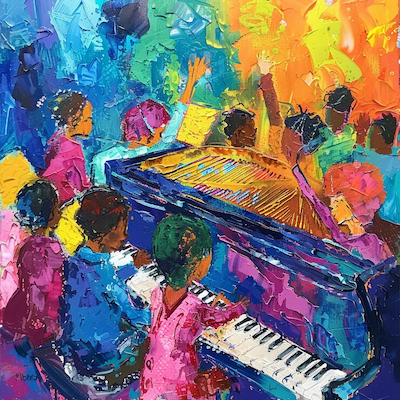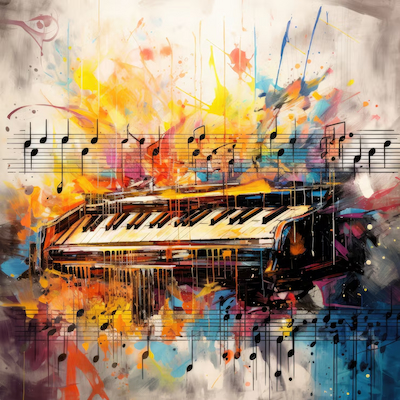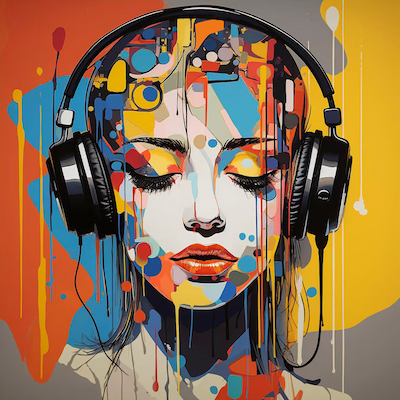
Art has always been a medium through which different forms of human expression can intersect and interact. Among these intersections, the relationship between music and painting stands out as one of the most powerful and evocative. While one speaks to the ears and the other to the eyes, both share a deep emotional core, capable of translating feelings, moods, and abstract ideas into forms that can be perceived and experienced.
When music and painting come together, a new kind of artistic dialogue emerges—one that transcends the boundaries of each discipline to create immersive, multi-sensory experiences.
How Do Interactions Between Music and Painting Work?
The interactions between music and painting are complex and fascinating, revealing how two art forms can intertwine to create unique sensory experiences. Music, with its rhythm and melody, can evoke emotions that, when translated into colors and forms in painting, result in works that speak to both the ear and the eye. This synergy allows artists to explore new dimensions of expression, where sound and image become partners in the communication of feelings and ideas.
When an artist paints under the influence of a musical piece, they may be guided by the cadence of the chords, allowing the music to shape their movements and aesthetic decisions. Similarly, when composing music, a musician might draw inspiration from a visual artwork, translating its colors and forms into notes and harmonies. This dialogue between the two arts not only enriches the creative process but also offers the audience a deeper and more engaging experience, where sound and image complement and reinforce each other.

Advantages of Exploring the Relationship Between Music and Painting
Exploring the relationship between music and painting offers numerous advantages for both artists and audiences. One of the main benefits is the expansion of creative possibilities. By combining these two art forms, artists can develop new visual and sonic languages, creating works that challenge conventions and stimulate the imagination. This fusion allows creators to express themselves in innovative ways, resulting in truly original and impactful pieces.
Another significant advantage is the enrichment of the viewer’s experience. When music and painting meet, the audience is invited into a multidimensional sensory experience. The emotions evoked by the music can intensify the appreciation of the visual work, and vice versa. This interaction creates a more immersive and engaging environment, allowing people to connect more deeply with the art and the emotions it conveys.
Additionally, exploring the relationship between music and painting can encourage collaboration between artists from different disciplines. Musicians and painters can work together on projects that combine their skills, resulting in works that are greater than the sum of their parts. This collaboration enriches the creative process and fosters dialogue among different artistic communities, broadening the reach and relevance of art in society.
Finally, this connection between music and painting can be a powerful tool for arts education. By teaching students about the interactions between these two art forms, educators can stimulate creativity and individual expression. Students learn to see and hear in new ways, developing a deeper appreciation for art in all its forms. This integrated approach can inspire the next generation of artists to explore new frontiers in their creative work.
How to Integrate Music and Painting in Artistic Projects
- Discover how synesthesia connects sound and image.
Synesthesia is a phenomenon that allows some people to experience a sensory overlap, where the perception of one sense can evoke another. By exploring this connection, artists can create works that reflect this experience, using colors and forms to represent sounds and rhythms. - Learn to create artistic compositions in dialogue.
Creating compositions that engage both music and painting involves understanding how the elements of each art form can complement each other. For example, an artist might choose a color palette that reflects the emotion of a musical piece, creating a visual harmony that resonates with the sound. - Explore mutual influences between different art forms.
Art history is full of examples of mutual influence between music and painting. Artists like Wassily Kandinsky, who believed in an intrinsic relationship between colors and sounds, and composers like Claude Debussy, who drew inspiration from visual artworks, show how these interactions can result in innovative and impactful creations. - Understand how sensory art can enrich the experience.
Sensory art, which involves the combination of different senses, can offer a richer and more engaging experience for the audience. By integrating music and painting, artists can create environments that stimulate not only vision but also hearing, allowing viewers to experience art in a more complete way. - See examples of artists who mix music and painting.
Many contemporary artists have explored the relationship between music and painting in their works. Artists like Olafur Eliasson and Anish Kapoor have created installations that incorporate both sound and visual elements, offering immersive experiences that challenge the boundaries between different art forms. - Find inspiration in projects that promote musical integration.
There are many projects and initiatives that promote the integration of music and painting, such as interactive exhibitions and live performances that combine both arts. These projects offer new opportunities for artists and encourage the public to engage more actively with art. - Integrating music and painting into artistic projects can be an exciting and rewarding journey. By exploring the interactions between sound and image, artists have the opportunity to create works that resonate on multiple levels, offering unique and memorable experiences for the audience. The fusion of these two art forms enriches the creative process and expands the reach and relevance of art in contemporary society.

Did You Enjoy Learning About the Relationship Between Music and Painting: Sound and Image in Artistic Dialogue?
The relationship between music and painting is a rich and fascinating field that truly deserves deeper exploration. When these two expressive worlds converge, they form a powerful artistic dialogue that transcends conventional boundaries. By blending auditory and visual languages, artists can craft immersive sensory experiences that resonate on multiple levels—emotionally, intellectually, and even physically. This synthesis between sound and image invites audiences to engage with art in a more holistic way, opening the door to new perspectives and emotional depths.
This synergy is not just a creative experiment—it is a celebration of the full spectrum of human imagination. It shows us how art can bridge the gap between what we hear and what we see, reminding us that expression is not limited to a single medium. Whether through a painting inspired by the dynamics of a symphony, or a musical composition shaped by the color and form of a visual work, this cross-disciplinary dialogue enriches both forms and unlocks new aesthetic dimensions.
Art is an ever-evolving universe, and the relationship between sound and image is just one of the many vibrant constellations within it. By embracing this dialogue, we don’t just expand our artistic horizons—we deepen our understanding of how interconnected our senses, emotions, and creative impulses truly are. So keep exploring, keep experimenting, and let your art become a symphony of color and sound.
Frequently Asked Questions
What is the relationship between music and painting?
The relationship between music and painting is deep. Both express emotions and connect through colors and sounds, creating artistic harmony.
How can music influence painting?
Music can inspire artists to choose certain colors and forms. Intense sounds might lead to bold brushstrokes, while soft melodies can result in delicate lines.
Are there artists who work with both music and painting?
Yes! Many artists blend sound and image, creating works that represent the relationship between music and painting: sound and image in artistic dialogue.
What emotions can music evoke in painting?
Music can evoke joy, sadness, or even calm. These emotions are reflected in artworks, providing a complete experience for the viewer.
How can I explore this relationship in my own artistic work?
Try listening to different music while you paint. See how the sounds influence your artistic choices and feel the connection between music and painting: sound and image in artistic dialogue.

